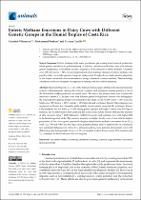Mostrar el registro sencillo del ítem
Enteric Methane Emissions in Dairy Cows with Different Genetic Groups in the Humid Tropics of Costa Rica
| dc.contributor.author | Villanueva, Cristóbal | |
| dc.contributor.author | Ibrahim, Muhammad | |
| dc.contributor.author | Castillo, Cristina | |
| dc.date.accessioned | 2014-10-17T05:39:16Z | |
| dc.date.available | 2014-10-17T05:39:16Z | |
| dc.date.issued | 2023 | es_ES |
| dc.identifier | 344214 | es_ES |
| dc.identifier.uri | https://repositorio.catie.ac.cr/handle/11554/118 | |
| dc.description.abstract | Enteric methane (CH4) is one of the main greenhouse gases emitted in livestock production systems with ruminants. Among the options to reduce such emissions, animal genetics is one of the factors that is taking relevance in recent years. The aim of the present study was to assess the emission of enteric CH4 in dairy cows with different genetic backgrounds. Sixteen cows belonging to the following three genetic groups were selected for this study: seven F1 (50% Jersey X 50% Gyr), five Triple cross (50% Jersey X 31% Holstein X 19% Sahiwal) and four Jersey. Enteric CH4 emissions were measured in all cows for 15 months, at the middle of each month, using the SF6 technique. Enteric CH4 emissions did not differ (p > 0.05) among genetic groups, although it varied with the stage of lactation, due to differences in milk yield and dry matter intake (DMI). Pasture DMI and the intensity of CH4 emissions (g kg1 DMI) differed (p < 0.05) between dry and lactating cows, with higher DMI in the lactation period, while CH4 emission intensity was higher for dry cows. Cows with the highest proportion of Bos taurus genes presented a higher annual mean methane conversion factor (Ym), with 7.22, 7.05 and 5.90% for the Triple cross, purebred Jersey and F1, respectively. In conclusion, non-significant differences in enteric CH4 emissions and Ym were detected among dairy cows with different genetic backgrounds. However, F1 cows tended to show lower enteric CH4 emission and Ym, compared to those with more Bos taurus genes. | es_ES |
| dc.format.extent | 11 páginas | |
| dc.language.iso | en | es_ES |
| dc.publisher | MDPI | es_ES |
| dc.relation.ispartof | Animals | |
| dc.relation.uri | https://doi.org/10.3390/ani13040730 | |
| dc.subject | HIBRIDOS | es_ES |
| dc.subject | HYBRIDS | es_ES |
| dc.subject | EMISION | es_ES |
| dc.subject | EMISSION | es_ES |
| dc.subject | ETAPA DE LA LACTANCIA | |
| dc.subject | LACTATION STAGE | |
| dc.subject | METANO | |
| dc.subject | METHANE | |
| dc.subject | COSTA RICA | |
| dc.subject | CROSSBREDS | |
| dc.subject | DRY MATTER INTAKE | |
| dc.subject | EMISSIONS INTENSITY | |
| dc.subject | METHANE CONVERSION FACTOR | |
| dc.subject | PUREBREDS | |
| dc.title | Enteric Methane Emissions in Dairy Cows with Different Genetic Groups in the Humid Tropics of Costa Rica | es_ES |
| dc.type | Articulo | es_ES |
| dc.creator.id | https://orcid.org/0000-0003-4218-7945 | |
| dc.creator.id | https://orcid.org/0000-0002-3458-4767 | |
| dc.creator.id | https://orcid.org/0000-0002-2467-6406 | |
| dc.identifier.status | openAccess |


